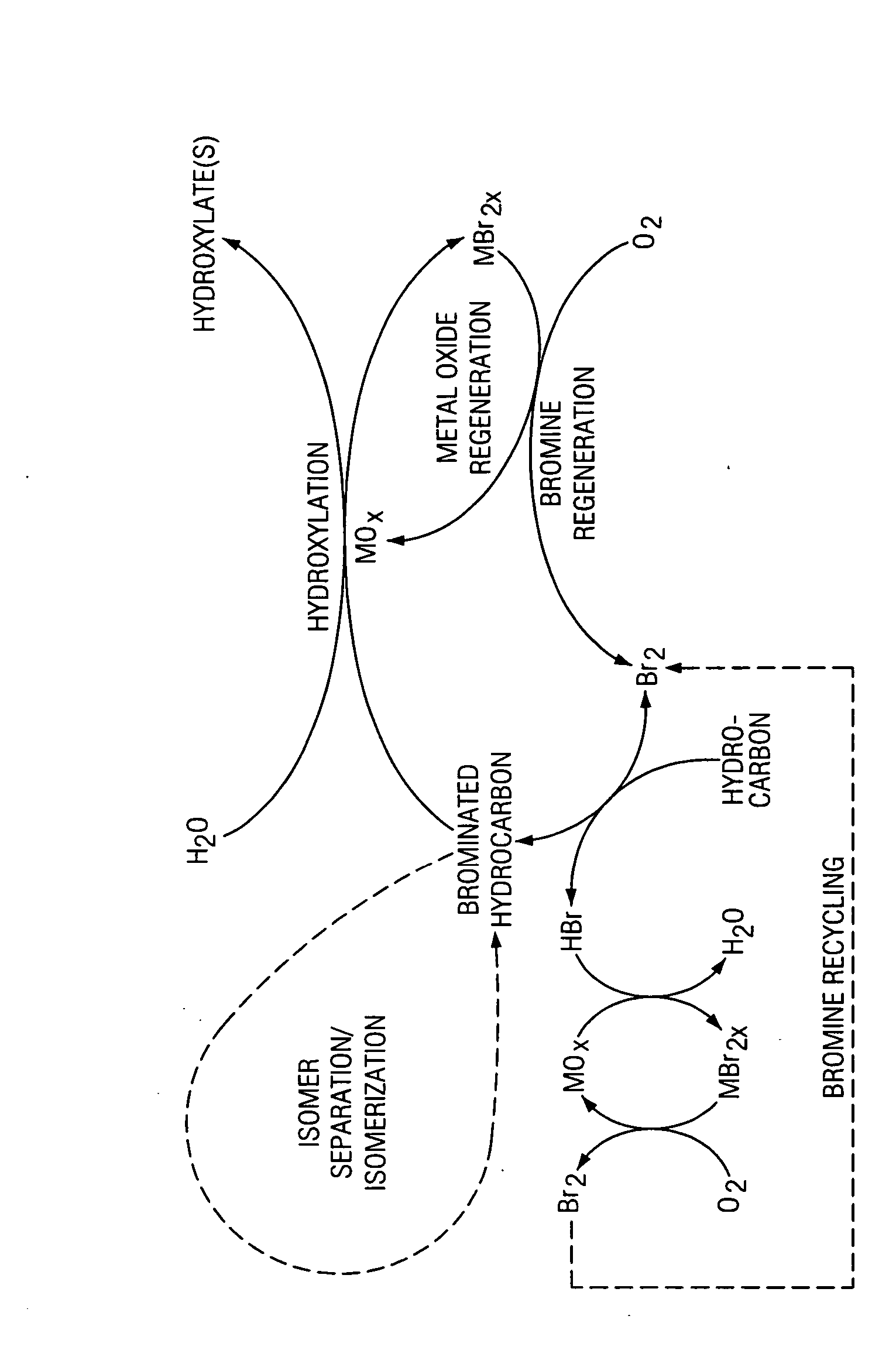Synthesis of hydroxylated hydrocarbons
- Summary
- Abstract
- Description
- Claims
- Application Information
AI Technical Summary
Benefits of technology
Problems solved by technology
Method used
Image
Examples
example 1
Ethane to 1,2-Dibromoethane to Ethylene Glycol
[0076] A stream of ethane with a flow rate of 5 standard ml / min is passed through a bromine bubbler held at 21° C. The resulting mixture of ethane and bromine having a molar ratio of 3.6:1 (ethane:bromine) is passed through a glass reactor having a 3.6 mm inside diameter. The glass reactor is packed with borosilicate beads and the average residence time in the reactor is 27 s. 100% of the bromine is converted. 24% of the ethane is converted with selectivities of 86% to ethyl bromide, 12% to 1,2-dibromoethane, 1% to 1,1-dibromoethane, and <1% of 1,1,2-tribromoethane.
[0077] 2.834 g of 1,2-dibromoethane (DBE) is reacted with 1.2 g of a fine CuO powder (Fisher Scientific, ACS grade) and 6 g of water at 150° C. in a stirred batch reactor (600 rpm) with pressure of 100 psig for 1 hour. 38% of the 1,2-DBE is converted with the following distribution:
ProductSelectivityEthylene glycol (mono)86%2-bromoethanol 7%Ethylene 2%Acetaldehyde 1%Diethy...
example 2
Propylene to 1,2-Dibromopropane to propylene glycol
[0078] A mixture of propane and bromine having a molar ratio of 3.6:1 (propane:bromine) is passed through a glass reactor having a 3.6 mm inside diameter. The glass reactor is packed with borosilicate beads and the average residence time in the reactor is 27 s. 100% of the bromine is converted. 28% of the propylene is converted with selectivity to 1,2-dibromopropane of greater than 99%.
[0079] 1.49 g of 1,2-dibromopropane (DBP) is reacted with 0.564 g of metal oxide and 9 g of water at 150° C. in a stirred batch reactor (600 rpm) at 100 psig for 1 hr. 30% of the 1,2-DBP is converted with the following distribution:
ProductSelectivity1,2-propylene glycol52%Propylene17%Propanal18%Acetone 7%Propylene oxide 2%Carbon dioxide2-bromopropylene1-bromopropyleneUnidentifiedbalance
example 3
Conversion of 1,3-Dibromopropane to 1,3-Propanediol
[0080] 1.494 g of 1,3-dibromopropane is reacted with 0.564 g of metal oxide and 9 g of water at 150° C. in a stirred batch reactor (600 rpm) at 100 psig for 1 hr. 28% of the 1,3-dibromopropane is converted with the following distribution:
ProductSelectivity1,3-propanediol83%3-bromopropanol10%1,6-dioxane3-bromopropyleneCarbon dioxideUnidentifiedbalance
PUM
| Property | Measurement | Unit |
|---|---|---|
| Fraction | aaaaa | aaaaa |
| Fraction | aaaaa | aaaaa |
| Fraction | aaaaa | aaaaa |
Abstract
Description
Claims
Application Information
 Login to View More
Login to View More - Generate Ideas
- Intellectual Property
- Life Sciences
- Materials
- Tech Scout
- Unparalleled Data Quality
- Higher Quality Content
- 60% Fewer Hallucinations
Browse by: Latest US Patents, China's latest patents, Technical Efficacy Thesaurus, Application Domain, Technology Topic, Popular Technical Reports.
© 2025 PatSnap. All rights reserved.Legal|Privacy policy|Modern Slavery Act Transparency Statement|Sitemap|About US| Contact US: help@patsnap.com

